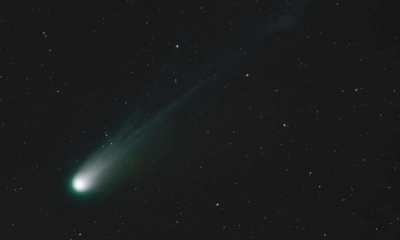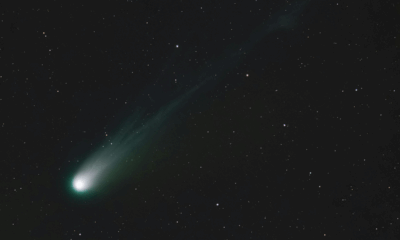Science
Asteroid Belt Thinning: Implications for Earth and Beyond

Recent research has revealed that the asteroid belt, located between Mars and Jupiter, is gradually losing mass. According to a comprehensive study published in *Nature Astronomy*, this once-thriving collection of rocky remnants from the early solar system is thinning at an alarming rate. The implications of this decline could significantly impact Earth’s future and our understanding of planetary evolution.
The asteroid belt is often misconceived as a dense region filled with countless objects. In reality, it consists of vast empty spaces, with a range of materials from tiny grains to the dwarf planet Ceres. Formed billions of years ago, this belt represents the debris left over from the solar system’s formation. Its existence has been maintained by the gravitational influence of Jupiter, which has prevented these materials from coalescing into a new planet.
Recent findings highlight that only a small fraction of the original material remains in the asteroid belt. Researchers have identified that the belt has been losing mass over eons due to various factors. Collisions among objects, gravitational interactions with Jupiter, and complex orbital dynamics are all contributing to this slow but steady erosion. The study indicates that as these interactions occur, they continuously reduce the number of asteroids, resulting in a diminishing population that is not being replenished.
Impact of a Thinning Asteroid Belt
While the thinning of the asteroid belt may not have immediate effects on daily life on Earth, it poses questions about our planet’s future interactions with space debris. The material lost from the asteroid belt eventually makes its way to Earth as meteorites. Most of these meteorites burn up upon entering the atmosphere, but some do reach the surface, contributing to the ongoing narrative of change on our planet.
Moreover, the depletion of the asteroid belt offers valuable insights into planetary evolution both in our solar system and beyond. Researchers have suggested that similar processes are at play in other solar systems, affecting the formation and development of planets across the galaxy. As the asteroid belt continues to transform, it serves as a dynamic indicator of how solar systems age and change over time.
The gradual disappearance of the asteroid belt is not merely a scientific curiosity; it provides critical clues about the fundamental processes governing the cosmos. As gravitational interactions and collisions dictate the fate of celestial bodies, these findings broaden our understanding of related objects, including comets and meteoroids, while also hinting at universal mechanisms shaping planetary systems throughout the universe.
Continuing Exploration
Despite its diminishing mass, the asteroid belt remains a focal point for scientific inquiry. Astronomers are using this ongoing transformation to gain deeper insights into the forces that drive changes in our solar system. The slow erosion of the asteroid belt serves as a cosmic reminder that even the most stable features in the universe are subject to constant change.
As our understanding of this dynamic region evolves, it highlights the interconnectedness of celestial bodies within our solar system. The research emphasizes that the study of the asteroid belt not only enhances our knowledge of Earth’s past but also informs predictions about the future of planetary systems. With each discovery, we move closer to unraveling the mysteries of our expansive cosmos, reminding us of the intricate dance of change that defines our universe.
-

 Entertainment2 months ago
Entertainment2 months agoAnn Ming Reflects on ITV’s ‘I Fought the Law’ Drama
-

 Entertainment3 months ago
Entertainment3 months agoKate Garraway Sells £2 Million Home Amid Financial Struggles
-

 Health2 months ago
Health2 months agoKatie Price Faces New Health Concerns After Cancer Symptoms Resurface
-

 Entertainment2 months ago
Entertainment2 months agoCoronation Street’s Carl Webster Faces Trouble with New Affairs
-

 Entertainment2 months ago
Entertainment2 months agoWhere is Tinder Swindler Simon Leviev? Latest Updates Revealed
-

 Entertainment3 months ago
Entertainment3 months agoKim Cattrall Posts Cryptic Message After HBO’s Sequel Cancellation
-

 Entertainment2 months ago
Entertainment2 months agoOlivia Attwood Opens Up About Fallout with Former Best Friend
-

 Entertainment2 months ago
Entertainment2 months agoMasterChef Faces Turmoil as Tom Kerridge Withdraws from Hosting Role
-

 Entertainment3 months ago
Entertainment3 months agoMarkiplier Addresses AI Controversy During Livestream Response
-

 Entertainment4 months ago
Entertainment4 months agoSpeculation Surrounds Home and Away as Cast Departures Mount
-

 Science2 weeks ago
Science2 weeks agoBrian Cox Addresses Claims of Alien Probe in 3I/ATLAS Discovery
-

 World2 months ago
World2 months agoCole Palmer’s Mysterious Message to Kobbie Mainoo Sparks Speculation





















